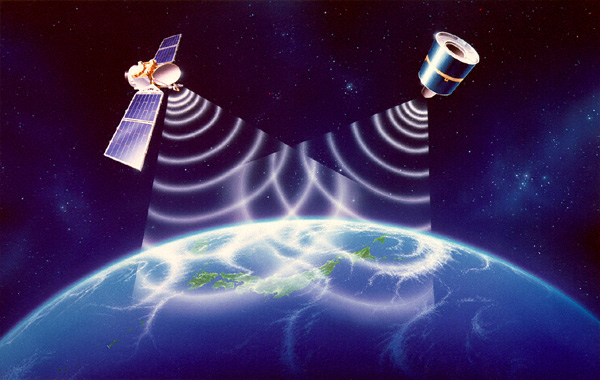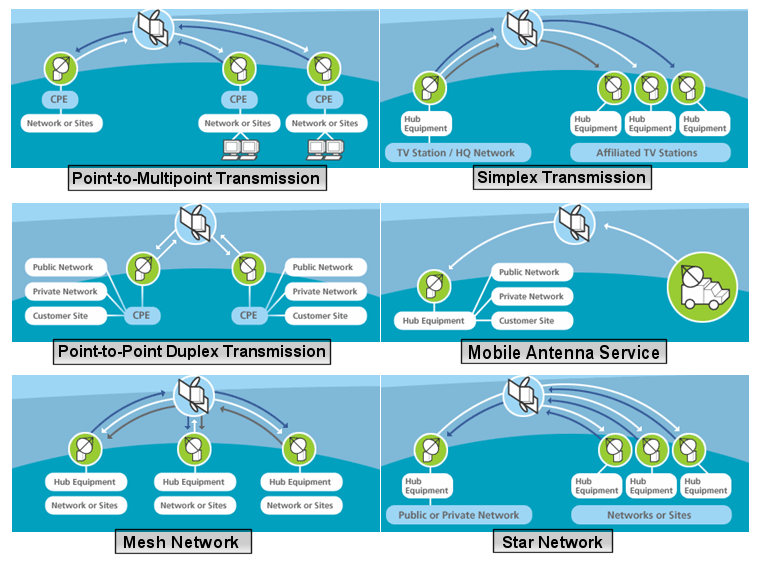Satellite Networking
From Computing and Software Wiki
Satellites are the height of modern communications technology. They provide global wide access to information by transmitting radio signals from orbit around the earth. Communication satellites are used in networks by retransmitting signals from a ground base to a large area of the earth.
Contents |
Advantages
• SEAMLESS: Satellite's inherent strength as a broadcast medium makes it ideal for the simultaneous distribution of bandwidth-intensive information to hundreds or thousands of locations [2].
• FAST: Unlike most terrestrial alternatives, satellite networks can be rolled out quickly and inexpensively to hundreds or thousands of locations, connecting cities or remote locations across a large landmass, where copper or fiber is cost prohibitive. Since satellite networks can be set up quickly, companies can be fast-to-market with new services [2].
• EXPANDABLE: Satellite networks are easily scalable, allowing users to expand their communications networks and their available bandwidth easily. In coordination with local vendors, expanding a network on the ground requires the ordering of new terminal components and the commissioning of increased bandwidth at each site [2].
• FLEXIBLE: Satellites can be easily integrated to complement, augment or extend any communications network, helping overcome geographical barriers, terrestrial network limitations and other constraining infrastructure issues [2].
• UNIVERSAL: Satellite communications are available virtually everywhere. A small constellation of satellites can cover the Earth's entire surface. And even the reach of a single satellite is far more extensive than what any terrestrial network can achieve [2].
• VERSATILE: Satellites can support all of today's communications needs - transactional and multimedia applications, video, voice, cellular networks, entertainment and breaking news [2].
-Bring broadband to the last mile of residences and businesses [2].
-Overcome regulatory issues that make alternative carriers dependent on incumbents [2].
-Deliver a communications infrastructure to areas where terrestrial alternatives are unavailable, unreliable or simply too expensive. [2]
Disadvantages
• Requires line of sight: In order to recieve the satellite signals your reciever needs to have a clear view of its target satellite in the sky. Factors which block the path such as clouds or dust caused by weather could disrupt the signals.
• Satellites are expensive: Satellites are not cheap to build. They require expensive components which have to operate in space. A satellite launch can cost anywhere between $50 million and $400 million [3].
• Large signal delays: Since satellites are so far from the earth and the speed of light is still the limiting factor for communication, satellites suffer from large signal delays compared to ground based network which operate over shorter distances. These delays make satellite communication unsuitable for interactive communication such as with video/audio and games.
Technology
A communications satellite is a specialized wireless receiver/transmitter — receiving radio waves from one location and transmitting them to another (also known as a “bent pipe”) — that is launched by a rocket and placed in orbit around the earth. Today, there are hundreds of commercial satellites in operation around the world. Those satellites are used for such diverse purposes as wide-area network communications, weather forecasting, television broadcasting, amateur radio communications, Internet access and the Global Positioning System. [1]
Satellites have many important uses, not just communications. Most modern weather reports rely on satellite information. Global Positioning systems work because of a linked set of satellites. Scientific studies of our planet, the atmosphere and the universe all rely on satellites. [1]
Orbits
There are three areas for satellite orbits: • GEO: Geostationary Earth Orbit • MEO: Medium Earth Orbit • LEO: Low Earth Orbit
GEO satellites orbit the earth directly over the equator, approximately 35 400 km (22 000 miles) up. At that altitude, one complete trip (orbit) around the earth takes 24 hours. Thus, the satellite remains over the same spot on the surface of the earth (geo) at all times, and stays fixed in the sky (stationary) from any point on the surface from which it can be "seen." [1]
MEO is defined simply as the area between LEO and GEO. The primary satellite systems there are the GPS (Global Positioning System) satellite constellations. [1]
LEO is between 200 and 1400 km above the earth. Satellites in LEO rapidly circle the earth and are typically in range of one location for only 90 minutes. Their main advantage is how close they are, providing shorter delays for faster communications. However, for consistent communications they require a constellation of satellites so that communications can be maintained as one satellite moves out of range and another moves within range of the ground station. LEO satellites are less expensive to build, typically less powerful, and have a shorter average life span. [1]
Communication
A satellite’s job in the communications network is to serve as a repeater. That is, it receives a signal from one location and rebroadcasts it so another station can receive the signal. Reception and retransmission are accomplished by a transponder. A typical satellite has 32 transponders.[1]
Complications
Problems arise when utilizing networking protocols such as TCP over large distance, high latency networks which are inherent to satellites. The problem is with the destination not receiving acknowledgments of TCP packets within a minimum time which causes the packets to be resent under the assumption that they never arrived. This is seen as congestion between the satellite and its base station and causes the sliding window to shrink and thus reducing throughput. This can be mitigated through some clever routing where a ground based host acts as a proxy to the satellite, immediately acknowledging the packets then forwarding them on to the satellite.
VSAT
A Very Small Aperture Terminal (VSAT) is a device, known as an earth station, that is used to receive satellite transmissions. [1]
The Antenna
The size of the dish is what is referred to by the “very small” component of the VSAT acronym. It is typically about 0.55-1.2m in diameter. It is usually mounted on a roof, an outside wall, or stuck into the ground. A 1.8m would be required for receiving C-band signals. [1]
The Indoor Unit (IDU)
The indoor unit is a small desktop appliance that converts between satellite analog communications and appropriate protocols for local devices such as telephones, computer networks, PCs, TVs, kiosks, etc. On top of basic conversion routines, IDUs can also contain value-added functionality such as security, network acceleration and other features. The indoor unit is connected to the outdoor unit with a pair of cables. [1]
Topologies
References
[1] Gilat.com
[2] Intelsat.com
See Also
Network-Based Software Architectures
Secure Electronic Transaction (SET) Protocol
External Links
howstuffworks.com - How satellites work
howstuffworks.com - How satellite TV works
RateItAll.com - Satellite service providers
--Crawfdr 22:04, 13 April 2008 (EDT)


